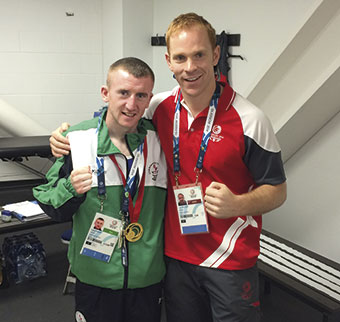A fantastic experience
QUB graduate John Haughey was part of the dental team at this summer’s XX Commonwealth Games in Glasgow
The 2014 Commonwealth Games was held in Glasgow and I was fortunate to be part of the dental team who provided dental support to the participating athletes.
Like the Olympics, the organising committee of the Commonwealth Games has a responsibility to provide dental support to athletes during the games. At Glasgow 20ı4, this comprised of a dental clinic in the Athletes’ Village and field of play dentists within the athlete medical teams at the rugby, hockey and boxing competition venues.
The dental clinic provided dental support to the athletes during their stay in the Athletes’ Village. The dental clinic was focused on providing emergency treatment, treating any dental conditions that could affect performance and provision of custom-fitted mouthguards. The field of play dentists were focused on treating any dental scenarios that arose during competition.
As part of the three-strong field of play dental team responsible for the boxing competition venue, I was based at the Scottish Exhibition and Conference Centre (SECC) complex which hosted seven sports; judo, wrestling, boxing, netball, gymnastics, weightlifting and powerlifting. A shift rotation was in place so there was always one dentist at the SECC complex.
A thorough training programme, which included orientation training, role-specific training and venue-specific training had taken place in the lead up to the Games. Regular communication from Scotland’s deputy chief dental officer Dr Tom Ferris and boxing medical lead Michelle Angus in the weeks before competition provided adequate preparation before the first shift. Each shift started with a briefing from the boxing athlete medical team lead for that shift and a practical rehearsal of possible scenarios that could be encountered during that day’s competition.
One of the major talking points from the boxing competition at Glasgow 20ı4 was the decision to remove head guards in the male competition. With comparison to the Olympics where head guards were worn, there was a massive amount of cuts, mainly from head clashes. This lead to a very active athlete medical room. For example, the second day of boxing competition alone saw ı7 boxers getting cuts.
Some of the better funded teams, such as Scotland, England and Canada, had their own medical staff within their boxing team and they treated any of their boxers who were hurt, but most teams relied on the athlete medical team in place.
Michael Conlan, a boxer from the Northern Ireland team, who won a bronze medal for Ireland at London 20ı2 was a regular visitor to the athlete medical team post bout. He was unfortunate to suffer a cut to the top of his head in his first fight (Fig ı) and a major cut to the forehead in his semi-final, which left him in doubt to pass the pre-bout medical for the final the next day.
After some great medical work from the medical lead Dr Kamran Ahmed – who I also had the pleasure of working with at the Olympics – which consisted of some deep stitching and gluing – Michael not only got through the medical but also through his final without the cut reopening (Fig 2).
On the dental front we also encountered cuts. These mostly occurred inside the lip and were due to poorly fitting mouthguards. An example of this is shown in Figs 3 and 4. The mouthguard worn by the boxer when he experienced the cut, was a boil and bite and was distorted, causing a rough edge in the area where the cut was sustained.
After the occurrence of these cuts and with the number of mouthguards that came out of the mouth during bouts, we decided to carry out a study into the type of mouthguards worn by the boxers competing at the quarter final stage of the competition. Surprisingly, at this stage of a major tournament, only 5ı per cent of the ı03 boxers in the study wore a custom-fitted mouthguard. Even though mouthguards are compulsory in boxing and the fact that they had access to a free custom fit mouthguard at the Athletes’ Village for the previous ı0 days before, the study shows there was a serious lack of knowledge of the different types of mouthguards available and the important values of a good mouthguard. This could be something we find in Gaelic football players over the next few years – that, even through it is now compulsory to wear a mouthguard, injuries may still occur due to poor mouthguards being worn.
From the experience of the dental injuries seen by the dental team at Glasgow 20ı4, it is clear that there is a need for dentists to continue to educate athletes and sports people on the need to wear a mouthguard and the importance of wearing a custom-fitted, pressurised, thermo-formed, laminated mouthguard for prevention of dental and orofacial trauma.
The finals of the boxing competition took place in the SECC Hydro with a capacity of ı2,500. The atmosphere was electric and it rounded of a fantastic experience. With nine boxers from Northern Ireland getting medals and four making it to the finals, it made it an even greater occasion. I would highly recommend any dentist to get involved in sports dentist opportunities.
ABOUT THE AUTHOR
Dr John Haughey graduated from Queens University Belfast in 2006 and completed the Sports Dentistry postgrad cert at UCL Eastman. He is the GPA sports dentistry advisor, chief dental officer of Vhi Dental and was a field of play dentist at London Olympics 2012 and Commonwealth Games Glasgow 2014.

